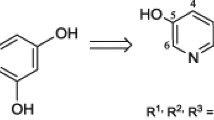Abstract
Quantum-chemical calculations using DFT, have been performed to explain the molecular structure antioxidant activity relationship of resveratrol (RSV) (1) analogues: 3,4-dihydroxy-trans-stilbene (3,4-DHS) (2); 4,4′-dihydroxy-trans-stilbene (4,4′-DHS) (3); 4-hydroxy-trans-stilbene (4-HS) (4); 3,5-dihydroxy-trans-stilbene (3,5-DHS) (5); 3,3′-dimethoxy-4,4′-dihydroxy-trans-stilbene (3,3′-DM-4,4′-DHS) (6); 2,4-dihydroxy-trans-stilbene (2,4-DHS) (7) and 2,4,4′-trihydroxy-trans-stilbene (2,4,4′-THS) (8). It was found that all compounds studied were effective antioxidants with the exception of 3, 5-DHS. The high antioxidant activity of both 3, 3′-DM-4, 4′-DHS and 3, 4-DHS may be due to the abstraction of the two hydrogen atoms of the para and ortho-position hydroxyls respectively, to form a quinone structure. Our results revealed that the antioxidant pharmacophore of 2,4-DHS and 2,4,4′-THS, exhibiting higher antioxidant activity than resveratrol, is the 2-hydroxystilbene, rather than 4-hydroxystilbene. Experimental observations were satisfactorily explained and commented.











Similar content being viewed by others
References
Fremont L (2000) Biological effects of resveratrol. Life Sci 66:663–673
Surh YJ, Hurh YJ, Kang JY, Lee E, Kong G, Lee SJ (1999) Resveratrol, an antioxidant present in red wine, induces apoptosis in human promyelocytic leukemia (HL-60) cells. Cancer Lett 140:1–10
Cai YJ, Fang JG, Ma LP, Yang L, Liu ZL (2003) Inhibition of free radical induced peroxidation of rat liver microsomes by resveratrol and its analogues. Biochim Biophys Acta (BBA) 1637:31–38
Tadolini B, Juliano C, Piu L, Franconi F, Cabrini L (2000) Resveratrol inhibition of lipid peroxidation. Free Radic Res 33:105–114
Sánchez-Moreno C, Jiménez-Escrig A, Saura-Calixto F (2000) Study of low-density lipoprotein oxidizability indexes to measure the antioxidant activity of dietary polyphenols. Nutr Res 20:941–953
Seybert DW, Milnar CM (1998) Antioxidant activity of resveratrol analogs in phospholipid oxidation. Free Radical Bio Med 25:S37
Pinto MC, Garcia-Barrado JA, Macias P (1999) Resveratrol is a potent inhibitor of the dioxygenase activity of lipoxygenase. J Agric Food Chem 47:4842–4846
Richard T, Pawlus AD, Iglesias ML, Pedrot E, Waffo-Teguo P, Merillon JM, Monti JP (2011) Neuroprotective properties of resveratrol and derivatives. Ann N Y Acad Sci 1215:103–108
Tili E, Michaille JJ (2011) Resveratrol, microRNAs, inflammation, and cancer. J Nucleic Acids. doi:10.4061/2011/102431
Vingtdeux V, Giliberto L, Zhao H, Chandakkar P, Wu Q, Simon JE, Janle EM, Lobo J, Ferruzzi MG, Davies P, Marambaud P (2010) AMP-activated protein kinase signaling activation by resveratrol modulates amyloid-beta peptide metabolism. J Biol Chem 285:9100–9113
Wu Y, Li X, Zhu JX, Xie W, Le W, Fan Z, Jankovic J, Pan T (2011) Resveratrol activated AMPK/SIRT1/autophagy in cellular models of Parkinson’s disease. Neurosignals 19:163–174
Murias M, Handler N, Erker T, Pleban K, Ecker G, Saiko P, Szekeres T, Jager W (2004) Resveratrol analogues as selective cyclooxygenase-2 inhibitors: synthesis and structure–activity relationship. Bioorg Med Chem 12:5571–5578
Wang MF, Li JG, Rangarajan M, Shao Y, Lavoie EJ, Huang TC, Ho CT (1998) Antioxidative phenolic compounds from Sage (Salvia offi cinalis). J Agric Food Chem 46:4869–4873
Fang JG, Lu M, Chen ZH, Zhu HH, Li Y, Yang L, Wu LM, Liu ZL (2002) Antioxidant effects of resveratrol and its analogues against the free-radical-induced peroxidation of linoleic acid in micelles. Chem Eur J 8:4191–4198
Stivala LA, Savio M, Fedarico C, Perucca P, Bianchi L, Magas G, Forti L, Pagnoni UM, Albini A, Prosperi E, Vannini V (2001) Specific structural determinants are responsible for the antioxidant activity and the cell cycle effects of resveratrol. J Biol Chem 276:22586–22594
Cheng JC, Fang JG, Chen WF, Zhou B, Yang L (2006) Structure–activity relationship studies of resveratrol and its analogues by the reaction kinetics of low density lipoprotein peroxidation. Bioorg Chem 34:142–157
Mikulski D, Górniak R, Molski M (2010) A theoretical study of the structure–radical scavenging activity of trans resveratrol analogues and cis resveratrol in gas phase and water environment. Eur J Med Chem 45:1015–1027
Queiroz AN, Gomes BA, Moraes WM Jr, Borges RS (2009) A theoretical antioxidant pharmacophore for resveratrol. Eur J Med Chem 44:1644–1649
Frisch MJ, Trucks GW, Schlegel HB et al. (2003) Gaussian 03. Gaussian, Inc., Pittsburgh
Dewar MJS, Zoebisch EG, Healy EF, Stewart JJP (1985) AM1: a new general purpose quantum mechanical molecular model. J Am Chem Soc 107:3902–3909
Nagaoka SI, Kuranaka A, Tsuboi H, Nagashima U, Mukai K (1992) Mechanism of antioxidant reaction of vitamin E: charge transfer and tunneling effect in proton-transfer reaction. J Phys Chem 96:2754–2761
Fukui K (1982) Role of frontier orbitals in chemical reactions. Science 218:747–754
Mikulski D, Molski M (2012) A quantum chemical study on the antioxidant activity of bioactive polyphenols from peanut (Arachis hypogaea) and the major metabolites of trans resveratrol. Theochem 981:38–46
Chen W, Guo P, Song J, Cao W, Bian J (2006) The Ortho hydroxy-amino group: another choice for synthesizing novel antioxidants. Bioorg Med Chem Lett 16:3582–3585
Trouillas P, Marsal P, Siri D, Lazzaroni R, Duroux JL (2006) A DFT study of the reactivity of OH groups in quercetin and taxifolin antioxidants: the specificity of the 3-OH site. Food Chem 97:679–688
Szabo A, Ostlund NS (1982) Modern quantum chemistry: introduction to advanced electronic structure theory. Dover , New-York
Cao H, Pan X, Li C, Zhou C, Deng F, Li T (2003) Density functional theory calculations for resveratrol. Bioorg Med Chem Lett 13:1869–1871
Berkowitz J, Ellison GB, Gutman D (1994) Three methods to measure RH bond energies. Phys Chem 98:2744–2765
Cao H, Cheng WX, Li C, Pan XL, Xie XG, Li TH (2005) DFT study on the antioxidant activity of rosmarinic acid. THEOCHEM 719:177–183
Jovanovic SV, Steenken S, Tosic M, Marjanovic B, Simic MJ (1994) Flavonoids as antioxidants. J Am Chem Soc 116:4846–4851
Parkinson CJ, Mayer PM, Radom L (1999) Assessment of theoretical procedures for the calculation of reliable radical stabilization energies. J Chem Soc Perkin Trans 2:2305–2313
Senthilkumar K, Kumaresan R (2012) A DFT study on the structural, electronic properties and radical scavenging mechanisms of calycosin, glycitein, pratensein and prunetin. Theochem 985:14–22
Author information
Authors and Affiliations
Corresponding author
Rights and permissions
About this article
Cite this article
Benayahoum, A., Amira-Guebailia, H. & Houache, O. A DFT method for the study of the antioxidant action mechanism of resveratrol derivatives. J Mol Model 19, 2285–2298 (2013). https://doi.org/10.1007/s00894-013-1770-7
Received:
Accepted:
Published:
Issue Date:
DOI: https://doi.org/10.1007/s00894-013-1770-7




